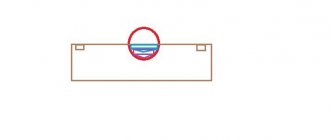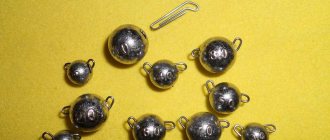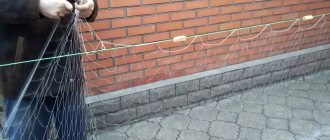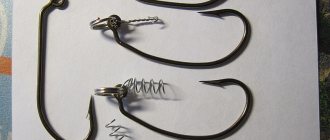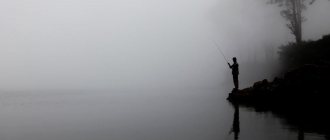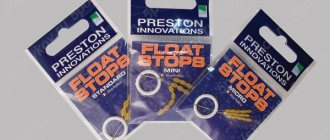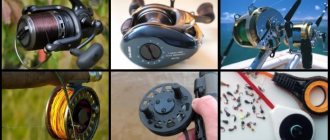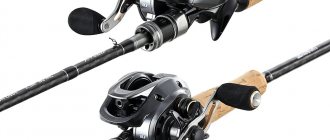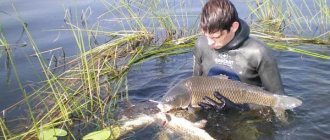Avid fishermen know that you can save money wisely on your hobby. For example, you can make your own molds for casting fishing weights and not spend money on purchased ones.
When fishing, sinkers are consumables along with fishing line and hooks. When catching large fish, the fishing line often breaks, and the rod may even break. It’s expensive to buy a new weight every time, because in stores their cost directly depends on the weight. The costs become even more noticeable if multiple gears are involved.
Advantages and disadvantages of homemade fishing weights
The abundance of homemade gear suggests that making it at home has many advantages:
- Saving money. The shape can be made from a variety of things, and the material for the sinker is much cheaper than the pre-made ones sold in stores.
- The casting process takes a little time.
- You can make gear in bulk or individually, it all depends on the patience of the fisherman and the casting method.
The disadvantages of homemade products include:
- the need to polish finished products;
- wasting time preparing forms and materials;
- lower manufacturing accuracy.
Plaster mold for casting
This form is suitable for repeated casting at home, when there is no need to rush anywhere and you can thoughtfully and thoroughly work on the sinker.
First you will need a sinker model. It is easily cut from a piece of wood or molded from plasticine. To make the mold, you need two identical boxes made of thick cardboard, proportional to the future sinker;
they are also easy to make. One needs to be filled with plaster and the model should be immersed halfway in it. While the plaster has not hardened, using a nail, a small groove-groove is pressed into it towards the impression, expanding outward like a funnel.
After the plaster has hardened, you should fill the second box with plaster, and put a model sinker into the first half of the mold, after covering it with a soap solution so that the halves do not stick to each other.
Now you need to tightly connect both halves, pressing them against each other. When the plaster hardens in the second half, all that remains is to separate them, take out the model - your reusable plaster mold is ready.
The process of casting a sinker is simple: press both halves of the mold tightly together with a clamp, melt the lead, carefully pour it into the mold in a thin stream and wait until the molten metal hardens.
Product Configurations
For now, let’s omit the division into factory-made and home-made, let’s look at professionally made gear. First of all, such forms can be divided into marine and freshwater.
Expert opinion
Knipovich Nikolai Mikhailovich
Zoologist, hydrobiologist. I am interested in fishing at a professional level.
Sinkers for sea fishing are, as a rule, larger, which is reflected in the size of the forms.
Matrices for filling can also be stamped or milled. Molten aluminum is poured into the stamped matrix. This is a cheap process because the required shapes are produced by the hundreds on an assembly line. The manufacturer decides which weights are popular and based on this he orders casting dies and then simply clones the molds. Milled products are more expensive.
Sinkers are made in almost any shape:
- diamond-shaped specimens;
- spherical;
- spoon-shaped;
- teardrop-shaped, etc.
The shape of the sinker is determined by the type of fishing and the reservoir where fishing is planned.
Which ones are needed for a fishing rod?
To answer this question, you need to decide on the type of catch you expect and what kind of fishing rods you will use.
For float
This type of fishing does not require a lot of weight. You just need to immerse the fishing line to the desired depth in relatively calm water. This task is accomplished by one or more pellets attached to a fishing line.
Expert opinion
Knipovich Nikolai Mikhailovich
Zoologist, hydrobiologist. I am interested in fishing at a professional level.
Experienced fishermen advise attaching several pellets by cutting them and inserting the fishing line into the cut. In this case, the smallest one should be closer to the hook. The distance between the pellets should be from 5 to 7 cm.
There is no consensus on what the size of a single pellet should be. Typically, balls with a diameter of 3 to 7 mm are placed.
For spinning
The presence of a sinker is not necessary for this fishing method. If the bait is heavy, casting is carried out without it. If the weight of the bait is small, more advanced products are required. Shape and weight become categorically important, since casting distance depends on them.
- Spoon-shaped weight. You can easily make it yourself by pouring molten lead into a hole in the ground.
- Rhombus. Such products are produced in factories. The average weight of a lead diamond is 30 g, although some specimens reach up to 75 g. They are designed for casting at an average distance.
- Ball. A mathematically ideal shape is not ideal for fishing. Such sinkers are not recommended for use on fast rivers, since the current can roll them along the bottom.
- Spindle-shaped weights. Good for long casts.
For the donkey
Expert opinion
Knipovich Nikolai Mikhailovich
Zoologist, hydrobiologist. I am interested in fishing at a professional level.
For this kind of donk fishing, weights are cast from gart or lead.
There are several nuances:
- For fishing on a flat coastal area, you need a heavy weight.
- If you plan to fish on a pond, lake or calm river, you need to take a sinker that is not too heavy.
- For fishing on muddy or rocky bottoms, it is better to use a round, conical or pear-shaped weight.
- On a sandy bottom and in strong currents, a flat sinker will help out.
- If there is a lot of debris at the bottom, choose a weighting agent like a vanka-stand. It has a floating top, and the weight occupies a vertical position, supporting the hooks with bait above the bottom.
DIY fishing sinkers
Do-it-yourself fishing sinkers are poured from any lead that you have on hand. The easiest way to obtain lead is to go to a tire shop and buy used balance weights.
Such lead will cost much less than if you buy sheet lead. You can buy the required number of kilograms and get a large number of weights from them for various purposes. The only thing to consider is the steel pieces molded into the middle of some of the weights.
The second way to extract lead is from old batteries. It is better to find points where they accept old batteries and buy them at a reasonable price. This is a more complicated method, since you will have to disassemble the batteries to remove the lead.
The third way to get lead out of cable braids. It is made of sheet lead with a thickness of 1, 1.5 and 2 mm. If you know any electricians, ask if they can get this braid. From such lead you can not only cast weights, but also cut strips for feeder feeders.
The most expensive way is to buy lead. It is sold in sheets and ingots. Better, of course, is sheet metal, but its size is very large. In such cases, fishermen unite and buy one sheet together.
You can also make weights with your own hands from old weights, which almost every angler probably has.
One thing is certain: absolutely any lead is suitable for casting sinkers with your own hands. It doesn't matter if it has impurities, or how dense or soft it is. Our task is weights for bottom fishing.
Plaster mold for casting
This form is suitable for repeated casting at home, when there is no need to rush anywhere and you can thoughtfully and thoroughly work on the sinker.
First you will need a sinker model. It is easily cut from a piece of wood or molded from plasticine. To make the mold, you need two identical boxes made of thick cardboard, proportional to the future sinker;
they are also easy to make. One needs to be filled with plaster and the model should be immersed halfway in it. While the plaster has not hardened, using a nail, a small groove-groove is pressed into it towards the impression, expanding outward like a funnel.
After the plaster has hardened, you should fill the second box with plaster, and put a model sinker into the first half of the mold, after covering it with a soap solution so that the halves do not stick to each other.
Now you need to tightly connect both halves, pressing them against each other. When the plaster hardens in the second half, all that remains is to separate them, take out the model - your reusable plaster mold is ready.
The process of casting a sinker is simple: press both halves of the mold tightly together with a clamp, melt the lead, carefully pour it into the mold in a thin stream and wait until the molten metal hardens.
Wooden mold for casting
It allows you to cast more complex lead weights - composite ones. Just like gypsum, it can withstand repeated use.
The form is made from two planks, the size and thickness corresponding to the future sinker. The planks must be made of hard wood. On each board the contours of the sinker and a groove for pouring lead are drawn. You will have to try hard here, since you need both halves of the casting to match when combined.
Recesses in the planks are cut with a chisel or chisel. They should be a little deeper than required. Also try to eliminate any gaps between the forms through which lead could leak out.
The sinker, smelted in a wooden mold, can be equipped with a wire eye. There are two options: either the eyelet is inserted into the gutter before pouring, or a special groove is made in one of the halves of the mold, where the eyelet is inserted before pouring.
The sinker can also be made sliding - to do this, instead of the eye, you need to insert a nail into the mold. After the lead hardens, the nail is removed with pliers and replaced with an empty ballpoint pen refill to protect the fishing line from rubbing with lead.
The process of casting a sinker in a wooden mold is similar to a plaster mold. Just take care to ventilate the room: during casting, the mold will rise a little. Take your time to separate the halves and wait until the lead has completely hardened, only then carefully remove the sinker by the eye. Take the time to sand out seams and rough edges.
Don't be upset if the sinker doesn't turn out symmetrical and solid. Everything can be corrected. Just when melting, do not forget to add lead - each melt evaporates part of the volume.
Where can I get raw materials for casting at home?
The raw materials for the mold can be:
- gypsum;
- potato;
- cardboard;
- paper;
- sand.
The following may be useful in production:
- ballpoint pen caps;
- plasticine;
- wires;
- pieces of plastic;
- talc;
- wire and other small things.
Expert opinion
Knipovich Nikolai Mikhailovich
Zoologist, hydrobiologist. I am interested in fishing at a professional level.
Shot is the most popular source of raw material for casting. It can be purchased at a hunting store. If you are a hunter, then you can take already shot shot found in the carcass of your prey.
You can ask for lead at car repair shops and tire shops. A lot of it usually accumulates there, and workers are ready to give away raw materials for free or for a nominal fee. Any scrap metal will do, quality doesn’t matter.
Where can I take a cast?
Lead is very easy to melt at 327.5 degrees. An ordinary burner does the job, and many people melt metal right in the kitchen.
This method is dangerous. Lead vapors poison the body and there is a risk of fire. If you do decide to work in the kitchen, be sure to open the windows or turn on the hood.
Melting lead over a fire looks preferable. This way there is no risk of poisoning, and there will be no unpleasant odor in the room. The disadvantage of this method is the length of the process. It takes a long time to maintain the flame; a lot of wood is wasted. Under no circumstances should you melt in the rain, as water getting into the liquid metal will cause splashes.
Expert opinion
Knipovich Nikolai Mikhailovich
Zoologist, hydrobiologist. I am interested in fishing at a professional level.
The best, but also the most expensive way is to work with an electric crucible. It can quickly and safely melt a large amount of metal, and do it at home, in the garage or on the street.
How to make cargo for the network
Many fishermen are often interested in how to equip a fishing net in order to obtain the highest catch rate. This question is asked not only by beginners, but also by experts in their field, as well as manufacturers of professional fishing gear. In this article we tried to answer this question in detail. As is known, the amount of float and loading is determined by the operating conditions of the net fishing gear. If the fishing net must stand on the bottom, then the sinking force of the load must exceed the buoyancy of the floats, which only straighten it, maintaining it in a vertical position. In this case, a certain amount of buoyancy is necessary so that caught fish or currents do not force the net to settle to the bottom. If the net should float near the surface, then the sinkers, on the contrary, should only straighten it, preventing it from floating. To calculate how much float and how much weight is needed for each specific network, you need to know the floating and weighting capacity of the materials used. As an example, we give the calculation of equipment for a fishing net made of nylon monofilament with the following parameters:
Safety precautions
When casting sinkers over an open fire, fire safety requirements must be observed. Keep water nearby to extinguish potential fires. NEVER pour it into a container with lead.
The room should be well ventilated, ideally have a hood. The melting process should not be left unattended, but you need to choose thick clothing.
Long sleeves and gloves are required to protect your hands from burns if lead is splashed. Make sure that there are no flammable substances or flammable objects near the stove, fire or electric crucible. This especially applies to clothing. In addition, it is very difficult to remove the chemical smell of lead from it.
How to make cargo for the network
Many fishermen are often interested in how to equip a fishing net in order to obtain the highest catch rate. This question is asked not only by beginners, but also by experts in their field, as well as manufacturers of professional fishing gear. In this article we tried to answer this question in detail. As is known, the amount of float and loading is determined by the operating conditions of the net fishing gear. If the fishing net must stand on the bottom, then the sinking force of the load must exceed the buoyancy of the floats, which only straighten it, maintaining it in a vertical position. In this case, a certain amount of buoyancy is necessary so that caught fish or currents do not force the net to settle to the bottom. If the net should float near the surface, then the sinkers, on the contrary, should only straighten it, preventing it from floating. To calculate how much float and how much weight is needed for each specific network, you need to know the floating and weighting capacity of the materials used. As an example, we give the calculation of equipment for a fishing net made of nylon monofilament with the following parameters:
Step-by-step instructions on how to make it yourself
Expert opinion
Knipovich Nikolai Mikhailovich
Zoologist, hydrobiologist. I am interested in fishing at a professional level.
If you follow safety precautions and have a basic understanding of physics, the process of creating a matrix and casting a sinker is not difficult.
You need to prepare the necessary tools, materials and clothing in advance so as not to be distracted from melting later.
Manufacturing of matrices
There are many materials for matrices. The use of some does not require special skills (plaster molds), others (potato molds) require using your imagination.
Plaster
The method allows you to make a disposable mold for a simple weighting agent. You will need:
- gypsum;
- planks;
- screws or small nails;
- candle;
- finished sample sinker;
- wire.
The process is divided into several stages:
- Make a composite box from planks, fastening them with bolts or nails.
- Thin the plaster so that there are no bubbles in it.
- Pour some plaster into the box and let it harden.
- Dip a sample of the weighting agent halfway into the partially hardened plaster. Drill a hole on the side of the workpiece through which liquid metal will flow. To prevent the hole from sticking together, place a cylinder of suitable dimensions in it, for example, the body of a fountain pen.
- Spread vegetable oil over the hardened plaster so that later it is easy to separate one half of the mold from the other.
- Place the other half of the box on top and pour plaster into it so that it completely covers the sample.
- When the plaster has hardened, carefully disassemble the box and remove the sample and the filler cylinder.
- Clean the mold and coat the inside with a layer of soot (soot from a burning candle).
- Attach the sinker loops along with the eyes. Assemble the shape and secure it with wire.
- The matrix should dry on its own for 1-2 days. Can be dried in the oven.
Potato
It is difficult to say who and how was the first to come up with this exotic method, but it works. You will need:
- large potato;
- knife;
- rosin;
- cargo sample.
In general terms the procedure looks like this:
- In an unpeeled large potato, a casting cavity is cut out to fit the size of the future product.
- A sample of the sinker is melted to such a state that a crust forms when it comes into contact with the potatoes.
- When the crust has cooled, additionally coat it with rosin so that the layer is 1-2 mm.
Expert opinion
Knipovich Nikolai Mikhailovich
Zoologist, hydrobiologist. I am interested in fishing at a professional level.
The first pour will need to be done very carefully, but then the mold will dry out more and more, and the process will go well.
From sealant
Silicone is highly versatile. The qualities of the material make it possible not only to create protective coatings or implants from it, but also to make good matrices for casting.
List of materials:
- heat-resistant sealant (GERMENT works well);
- talc;
- planks;
- screwdriver;
- soft brush;
- weighting material sample.
Mode of production:
- Make wooden formwork.
- Mix talc and sealant in a 1:1 ratio. The consistency should be like plasticine.
- Lubricate the inside of the formwork with talcum powder.
- Place the finished mass in the formwork so that it touches the walls, but only occupies half the volume of the box.
- Level the mass inside the formwork.
- Take the model of the future sinker and press it halfway into the mass.
- Using a screwdriver, make a groove for pouring lead.
- Using a stick dipped in talcum powder, make blind holes in the mass so that you can then adjust the two parts of the mold.
- Place the formwork in the refrigerator for several hours to harden.
- Mix the sealant with the talcum powder again and make the other half of the mold.
- Remove the formwork from the refrigerator and use a brush to apply a layer of talc, which will serve as a separator.
- Add the fresh mass to the formwork and compact it thoroughly.
- Dry the product for 2 hours, then remove the formwork.
From cardboard
Expert opinion
Knipovich Nikolai Mikhailovich
Zoologist, hydrobiologist. I am interested in fishing at a professional level.
The material can be ordinary thick paper.
This simplest method allows you to make a workpiece quickly, but it will require processing with a file.
Materials:
- sand;
- thick paper;
- old dishes.
To make a mold, you need to roll the cardboard into a cone and insert it into sand poured into any container. Then lead will be poured into the cone, the paper will burn, but during these seconds the metal will already harden a little and take the desired shape.
Watch how to make this load with your own hands in the video:
Making weights
This operation is inextricably linked with the creation of the matrix. Sinkers can be of different shapes depending on the type of tackle. This must be taken into account when creating matrices.
For the donkey
Expert opinion
Knipovich Nikolai Mikhailovich
Zoologist, hydrobiologist. I am interested in fishing at a professional level.
Conical, spherical and cylindrical weighting agents are used for donks.
If you don’t have a sample at hand, you can make a model from plasticine, pen caps, paper, etc. Consider the specifics of the chosen form creation method.
For a float rod
Since pellets are usually used as weighting agents for fishing with a float, it is better to take large pellets as a sample .
The mold will have to be made from plaster or sealant, since potatoes and cardboard with sand do not allow you to achieve the desired shape and size. It is more convenient to make a number of holes in the mold for lead. This way it will be possible to make several weights at once.
Sliding
Expert opinion
Knipovich Nikolai Mikhailovich
Zoologist, hydrobiologist. I am interested in fishing at a professional level.
This type of weighting material is used both on spinning rods and on float rods. It is considered more perfect because the fish, having grabbed the bait, does not feel the weight of the sinker.
It slides freely along the fishing line. There is a reliable way to make several products at a time.
Required materials:
- an oblong cylindrical object (for example, a large drill);
- the wire;
- wire;
- scotch;
- sand;
- hacksaw for metal;
- paper.
How to make:
- Roll the drill into the paper, remove it, and secure the paper with tape so that the roll does not unwind.
- Cut a piece of wire so that it is 2-3 cm longer than the roll, and insert it into the tube.
- Bend both ends and fasten with short pieces of wire to secure the wire inside the tube.
- Align the wire so that it is stretched more or less in the center of the tube.
- Stick the tube into the sand.
- Pour molten lead into the open end of the tube. If necessary, use pliers to trim the wire so that it is centered.
- Remove the remaining paper, cut the long lead blank into pieces to fit the size of the sinkers.
- Squeeze the wire out of the blanks.
- Using sandpaper or a file, give the workpieces the desired shape.
With rubber shock absorber
This tackle is very effective, but is prohibited in a number of regions. The weights for such a bottom must be very heavy: up to 400 g. They must be made flat and rough.
Expert opinion
Knipovich Nikolai Mikhailovich
Zoologist, hydrobiologist. I am interested in fishing at a professional level.
For the best adhesion to the ground, you can place pieces of soft and thick wire into the sinker during casting.
If they stick out like the arms of an anchor, the sinker will lie very well on the bottom, and when it catches on an obstacle, the soft wire will straighten out, and it will be possible to pull out the tackle.
For such donks, all the described methods are convenient, except for the potato method: it is almost impossible to find potatoes of a suitable size.
Collapsible Cheburashkas
Sinkers of complex shapes, such as collapsible Cheburashkas, are best made in a plaster mold.
Materials:
- gypsum;
- cardboard, plastic or matchbox;
- a little plasticine;
- knife
- metal plate 4 x 0.8 mm, and 10+ cm in length;
- soap;
- lead;
- container for melting lead;
- wire;
- sample of collapsible Cheburashkas.
Manufacturing process:
- Make formwork from plastic or cardboard; even a matchbox will do.
- Remove the eye from the sample sinker and insert the metal plate.
- Mix the plaster and pour it into the formwork.
- Submerge the sample sinker on the plate halfway into the plaster.
- When the plaster dries, you need to lubricate the surface with soap.
- Mix more plaster and pour it into the formwork to completely hide the sinker.
- When the plaster dries, remove the formwork.
- Without waiting for complete drying, separate the halves of the mold.
- In the still wet plaster, make channels for pouring lead and venting air.
- After complete drying, the forms can be used for their intended purpose.
- Make ears for Cheburashkas from wire.
DIY sinkers
TOP popular products for fishing
– buy with good discounts for personal use and as a gift to friends and acquaintances.
Buy quality products at affordable prices in the best fishing online stores
. Give gifts to yourself and your loved ones!
we are in social networks
– follow us on , , and Instagram. Stay up to date with the latest site news.
Making homemade weights is not only useful, but also a very simple procedure. Weights are needed mainly by bottom fishers and spinning fishermen for rigs with retractable mounting.
Even a novice angler can master this technique. The main thing is to have lead, create a fire source and find suitable utensils.
In this article we will learn how to make fishing sinkers, where to get lead and what fire sources are best.
Where can I get lead?
Do-it-yourself fishing sinkers are poured from any lead that you have on hand. The easiest way to obtain lead is to go to a tire shop and buy used balance weights. Such lead will cost much less than if you buy sheet lead.
You can buy the required number of kilograms and get a large number of weights from them for various purposes. The only thing to consider is the steel pieces molded into the middle of some of the weights. It is advisable to remove them during melting. But you usually don’t come across many such sinkers.
The weights can be melted all together without sorting them by density.
The second way to extract lead is from old batteries. It is better to find points where they accept old batteries and buy them at a reasonable price. This is a more complicated method, since you will have to disassemble the batteries to remove the lead.
The third way to get lead out of cable braids. It is made of sheet lead with a thickness of 1, 1.5 and 2 mm. If you know any electricians, ask if they can get this braid. From such lead you can not only cast weights, but also cut strips for feeder feeders.
The most expensive way is to buy lead. It is sold in sheets and ingots. Better, of course, is sheet metal, but its size is very large. In such cases, fishermen unite and buy one sheet together.
You can also make weights with your own hands from old weights, which almost every angler probably has.
One thing is certain: absolutely any lead is suitable for casting sinkers with your own hands. It doesn't matter if it has impurities, or how dense or soft it is. Our task is weights for bottom fishing.
We pour out a sinker for a donkey with a rubber shock absorber
Let's first look at how to make fishing weights for elastic bands. We will perform this procedure outside. We will need a fire or a gas burner with a spray can. In the first case, it takes more time to melt lead, but there is no need for equipment or extra costs.
Melting lead with a gas torch takes just a few minutes, but requires a can of gas.
We also need a tablespoon, a lead tin and a little patience. We will dump the load in the ground. We find a damp piece of land and press a hole with a spoon to make a boat like this. Next, take a stick and insert it into one of the ends of the resulting form. Then we wait for the lead to melt.
After it becomes liquid, pour it into the resulting recess. We wait until it cools down a little, after which we take out the stick. The result will be a load weighing about 300-350 grams. It will lie well on the bottom and is easy to cast over long distances. We inserted a stick to create a hole in the weight.
You can pour several pieces at once if you can get a fire source with a high temperature.
Many fishermen ask the question: “How to make fishing sinkers for elastic bands of light weight, so that they stick well to the bottom and are not carried away by the current. Making such weights is quite simple.
You need to take 3-4 pieces of wire 10 cm long and bend them into staples. Then place it in the recess. After pouring you will get a spider like this. After casting, the weight will lie in one place, and these pieces of wire will hold it.
The weight of the cargo in this case may not exceed 150 grams.
Pour out the cone weights
Donkers and spinning fishermen often use hand-made conical weights. The former are used because they fly far and accurately, while spinners use them in spaced rigs. Making these weights yourself is very easy. You don't even need forms. We will need hard paper, with which we will make cones in the form of small bags.
We also need thin and stiff wire. From it we will make eyelets through which the weights will be attached to the main fishing line.
We will pour the sinkers with our own hands in exactly the same way as last time. Instead of a gas burner, you can use a portable one with two burners. It will be possible to pour in two containers to make the process faster. In this case, place the jars on the stove at intervals of 5 minutes. The lead has melted in one, pour it straight into the molds. After this operation, the lead should melt in the second container.
We insert wire staples into the paper molds so that the eye sticks out from the top of the cone. We immerse the molds in the ground so that they take a vertical position. We select the size of the molds experimentally. We estimate by eye what kind of weight we need.
As a standard, you can take a 35 gram weight and look at it. It will be enough to pour out the first batch of sinkers for fishing with your own hands. We will use the resulting weights as samples when we make molds for the next batches.
The pouring process is identical to the previous one. You can use an unnecessary metal mug as a container for lead. It is convenient to take it by the handle and pour lead from it. To avoid burning your fingers, it is better to wear gloves on your palms. After pouring, you should wait a little and remove the weights from the molds. We just tear off the paper without sparing, since initially the molds are disposable.
Pour out flat sinkers for donks
In bottom fishing, flat weights are often used. As a rule, they have an oval shape. Such sinkers lie well on the bottom even when fishing in strong currents. How to make such sinkers for fishing? To do this, cut out an oval piece 4 cm long and 2 cm wide from elastic 3 mm thick. You can also make heavier weights. For this we will use larger workpieces
Next, we make 7-8 dents in the ground, as in the previous case, when we poured out a large sinker for the elastic band. We will be making two types of weights. One type is sliding, and the second is with an eye. To pour the sliding weights, cut thin wire into pieces that are 1 cm longer than the length of the recesses. Insert the wire into these recesses.
To obtain weights with eyes, we will do exactly the same as when pouring cone weights. Only the ear this time will peek out from the recess. If necessary, you can drill holes on the edge of the sinkers
Carefully pour the molten lead into containers and wait about 5 minutes. After this, you can carefully collect them with a spoon.
Pour fishing weights into molds
To obtain calibrated weights of various shapes and weights, metal molds of various types are used.
Let's look at how to cast weights in a metal mold of this type:
The form consists of two halves. After pouring, you should get sinkers weighing 130 grams with swivels.
In addition to lead, we will need two clamps for clamping forms, swivels and files with cutters for removing roughness from the resulting weights. Before casting the weights, lubricate all molds with machine lubricant so that the weights can be easily removed after pouring.
First, we insert the swivels into the four sinker molds.
Then we press the halves together with clamps.
Next, set to heat the lead in a suitable container. This mold has large enough sprues, so there won't be any problems with casting. That part of the lead that remains near the sprues is collected and used in the next pour.
Place the mold on a flat surface. When the lead melts, we begin to pour:
We clamp the container in which the lead is melted with pliers, and begin to carefully pour the lead into the holes.
After pouring, wait a few minutes and disassemble the mold. The result should be ribbed weights like this:
It needs to be slightly processed with a file. Remove the section from the sprue side. Large growths can be bitten off with nippers, after which the area can be treated with a file. As a result, you can make a very large number of sinkers.
They can be used in feeder fishing to break through the bottom. Such heavy sinkers are useful for bottom fishers when fishing in strong currents. They fly far and hold the bottom well.
conclusions
We looked at the simplest ways to cast sinkers. You can make weights even if you don't have molds. If you have metal molds, you can cast weights to order, making money on it. The main thing in this process is to find lead and a well-ventilated place. Remember that casting lead indoors is harmful.
There are also ways to cast weights in plaster and wooden forms. But for this you also need to make forms, which only complicates the task. And the period of their use is not very long. It is important to understand that weights are consumables. Therefore, you should not spend a lot of time on this process, trying to get products of perfectly correct shapes.
Good fishing online stores
will allow you to purchase any
fishing goods
at competitive prices!
Follow us on social networks
– through them we publish a lot of interesting information, photos and videos.
Popular sections of the site:
The fisherman's calendar will allow you to understand how all the fish bite depending on the time of year and month.
The fishing gear page will tell you about many popular gear and devices for fishing.
Fishing baits – we describe in detail live, plant, artificial and unusual ones.
In the bait article you will get acquainted with the main types, as well as tactics for using them.
Learn all the fishing lures to become a real fisherman and learn how to choose the right one.
Source: https://ribalka-vsem.ru/index/gruzila_svoimi_rukami/0-938
